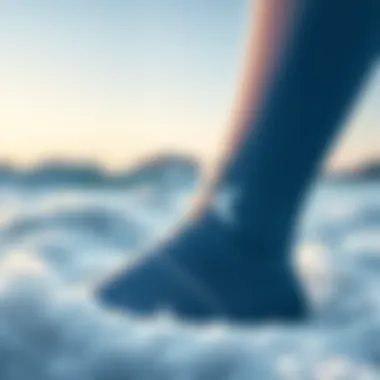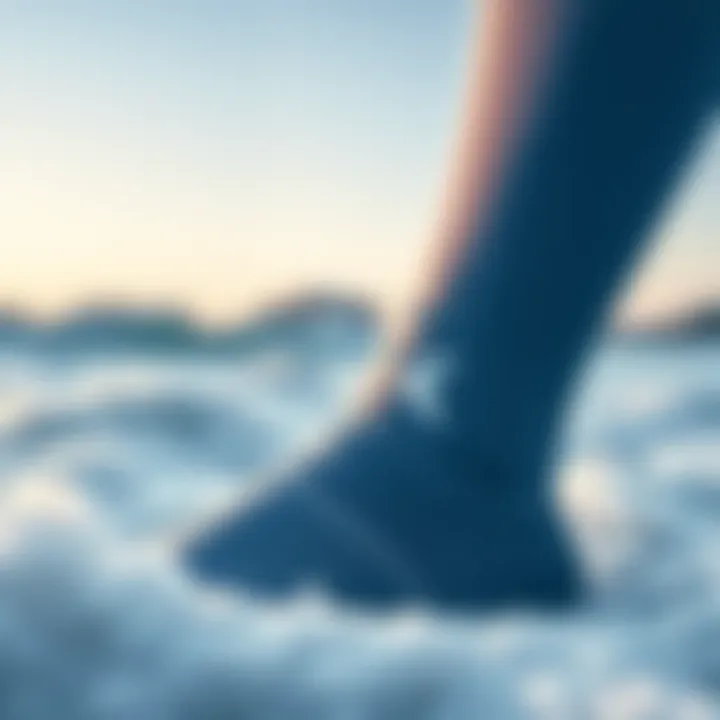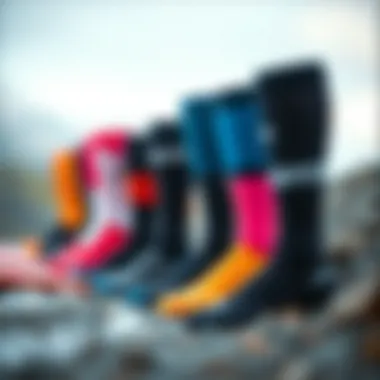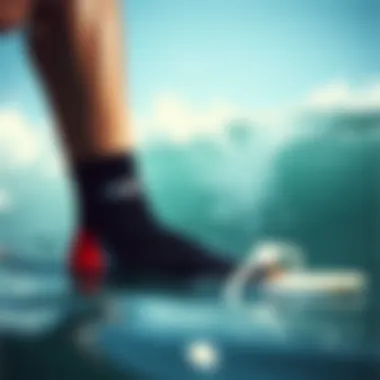Neoprene Surfing Socks: Comfort and Performance Guide


Intro
When it comes to enjoying water sports, having the right gear can be the difference between a thrilling experience and a chilly disaster. On this note, neoprene surfing socks play a pivotal role, often overlooked yet essential for kiteboarders and other water enthusiasts. Their snug fit and insulating properties protect against cold water, allowing you to focus on the ride without constantly worrying about your comfort.
In this guide, we will explore everything from the unique qualities of neoprene material to the various styles available in the market. Moreover, we'll dive into practical tips for selecting the right pair, maintaining them, and integrating these socks into your overall surfing gear. Whether you are new to the waves or have been riding them for years, understanding the advantages of neoprene socks will enhance your performance and enjoyment.
Techniques for Kiteboarding Enthusiasts
Kiteboarding requires not just skill, but the right equipment tailored to your techniques. Neoprene surfing socks can significantly enhance your experiences on the water, whether you're just starting or looking to elevate your maneuvers.
Beginner Techniques
For newcomers, establishing a solid foundation is key. Here are a few techniques where the right equipment, including neoprene socks, can enhance your learning:
- Stance: Your foot positioning affects balance. Wearing neoprene socks allows for flexibility while keeping your feet warm and comfortable.
- Basic Water Start: When you get into the water, neoprene socks provide grip and earth and stability, making it easier to start picking up the board.
- Controlled Turns: As you learn to steer, the snug fit of neoprene socks helps you feel every shift, contributing to smoother transitions.
Advanced Maneuvers
For those who have mastered the basics, advanced techniques require a higher level of precision. No one wants foot cramps or cold toes when trying a new trick. Here’s where neoprene socks shine:
- Jumping: Proper foot spacing is crucial for executing jumps. The added insulation helps maintain proper blood flow, ensuring you're more agile as you ride the wind.
- Downloops: These aggressive turns require a solid grip on the board. Neoprene socks enhance your control, allowing you to execute these moves with confidence.
- Surfing Transitions: Combining kiteboarding with surf tricks involves a lot of movement. A good pair of neoprene socks provides both grip and comfort, enhancing performance without distraction.
"A good ride begins with the right gear beneath your feet."
Selecting the Right Pair of Neoprene Socks
When it comes down to choosing neoprene socks, consider a few factors:
- Thickness: Generally, a thickness between 2mm to 5mm works best, depending on your personal preference and local water temperatures.
- Fit: Ensure a snug fit without being overly tight. Remember that you want to maintain circulation in your feet.
- Sole Design: Look for reinforced soles for durability, especially if you're navigating rocky or coral-laden waters.
In summary, neoprene surfing socks are an integral choice for kiteboarding enthusiasts looking to enhance their performance and comfort on the water. Stay tuned for more insights on how to care for these essential items and elevate your surfing game!
Understanding Neoprene Material
Neoprene is not just any material; it's the secret sauce behind the comfort and performance of surfing socks. Understanding its characteristics can help you appreciate why these socks are crucial for anyone who enjoys water sports. From composition to its unique properties, grasping the essence of neoprene is key for every water aficionado.
Composition and Properties
Neoprene is a type of synthetic rubber that got its start during the 1930s. It’s made from polychloroprene, a material that brings a mix of flexibility and strength to the table. One of the hallmarks of neoprene is its ability to resist damage from the elements. Here are some notable properties:
- Water Resistance: Keeps your feet dry and cozy, even in chilly waters.
- Flexibility: Allows for a comfortable fit that moves with your feet, making it easier to navigate your board.
- Buoyancy: Helps to maintain warmth while you're surfing or kiteboarding, providing added insulation against the cold.
With these properties, it’s clear that neoprene lays a solid foundation for efficient surfing socks, ensuring that athletes can focus on their performance without distraction.
Thermal Insulation Benefits
Surfing often means braving chilly water temperatures. This is where the thermal insulation of neoprene steps in and saves the day. Neoprene socks are crafted to provide an extra layer of warmth that prevents your feet from feeling like ice blocks. Here’s how they help:
- Trapping Body Heat: The design allows for minimal water entry. Essentially, once these socks are on, a thin layer of water warms up and stays trapped, keeping your toes toasty.
- Reduced Heat Loss: Unlike open-cell designs, the closed-cell neoprene used in most socks minimizes heat escaping, letting you surf longer without feeling like you need to rush back to the beach.
Whether you’re battling against rugged waves or just enjoying a calm day of surfing, thermal insulation directly impacts your performance.
Durability and Resistance
In the world of water sports, durability is non-negotiable. Neoprene isn’t just tough—it’s built to withstand the harsh conditions of ocean exposure. This means your surfing socks won’t give up on you after just a few outings.
- Damage Resistance: Neoprene holds its own against punctures and abrasions. When you’re in the surf, rocks and corals can be a real pain, but a robust neoprene sock can stand up to those hazards.
- UV Resistance: Prepping for sunshine? Neoprene socks often include additives that resist wear from UV rays, meaning your gear won’t deteriorate as quickly under the scorching sun.
Overall, understanding the unique properties of neoprene goes a long way in selecting a trustworthy pair of surfing socks that will not only keep your feet happy but also enhance your overall surfing experience. It’s a blend of comfort, warmth, and resistance, tailored just for water sports lovers.


The Purpose of Surfing Socks
Neoprene surfing socks serve more than just a trendy look when you hit the waves. These specialized accessories are pivotal in enhancing the overall surfing experience, especially for those who dwell in cooler waters. Having an understanding of the purpose behind these socks can greatly impact the comfort and efficiency during water sports activities.
Cold Water Comfort
When the temperature dips, surfing can become more than just a little uncomfortable. A common misconception is that wearing regular socks is adequate, but that couldn't be further from the truth. Neoprene socks are designed specifically to tackle chilly waters. They provide a barrier that retains body heat, keeping your feet warm while you're gliding through the surf.
The insulating properties of neoprene combat the cold, allowing for extended sessions without the distracting chill creeping up your legs. By maintaining warmth, these socks allow surfers to focus on their skills rather than shivering through a session. In addition, wearing sock can help avoid that unpleasant initial shock when you step into frigid water.
Protection Against Sea Life
Beyond just keeping your toes toasty, neoprene socks also offer critical protection against marine life. Anyone who's surfed knows that feet can be vulnerable to unexpected encounters with underwater critters. From sharp coral to curious fish, the ocean can harbor hidden hazards.
The robust nature of neoprene serves as a protective layer, preventing cuts and abrasions that could quickly ruin a good day out on the water. A sock might just feel like an extra layer, but trust me, it can save you a world of discomfort. Also, if you ever step on a sea creature, the extra thick material provides a shield, giving you peace of mind while focusing on riding the waves.
Enhancing Grip on Board
Surfing is a fine balance of power, skill, and grip. If your feet slip, well, you know what comes next—a tumble into the drink. Neoprene socks typically feature specialized grips on the soles. This added traction is invaluable, especially when wading through water or battling the forces of nature in a swell.
A solid grip can do wonders for stability and performance. With a sock that allows for better connection with your board, you have enhanced control. Whether you prefer riding waves or tackling a technical kiteboarding course, these socks make an impressive difference. If you're serious about improving your performance in the water, seeking out a sock that provides solid grip is essential.
"Having the right gear can shift your entire experience from merely making do to truly excelling. Neoprene socks play a key role in that transformation."
By comprehending the distinct purposes of neoprene surfing socks, water sports enthusiasts can make educated choices, layer their gear effectively, and enjoy an overall enhanced surfing experience. These socks do an excellent job of blending comfort, protection, and performance enhancement into one sleek package.
Types of Neoprene Surfing Socks
When it comes to choosing the right neoprene surfing socks, understanding the different types available is essential. Each design serves specific functions and caters to various preferences among surfers, kiteboarders, and other water sport enthusiasts. Selecting the appropriate sock can significantly impact comfort, warmth, and performance in the water. In this section, we will delve into three prominent types of neoprene socks: ankle-length socks, knee-length socks, and full-length options, each of which serves its unique purpose.
Ankle-Length Socks
Ankle-length socks are a popular choice among surfers who prefer a lightweight and less restrictive option. These socks typically extend just above the ankle, providing a snug fit that keeps sand and small debris out while giving maximum freedom of movement. Given their minimalist design, they are particularly favored in warmer water conditions.
The key benefits of ankle-length neoprene socks include:
- Flexibility: Their low-cut design allows for a greater range of motion for your feet and ankles, which is particularly beneficial for board control and maneuverability.
- Comfort: Many find ankle-length socks less fussy when it comes to putting them on or taking them off, making them an excellent choice for quick sessions or warmer days.
- Light Weight: Typically made with thinner neoprene material, these socks do not weigh you down, keeping your focus on the waves rather than your gear.
Knee-Length Socks
Knee-length neoprene socks are a middle ground for those seeking more warmth without sacrificing flexibility entirely. They reach just below the knee, providing extra coverage against cold waters while still maintaining a good level of movement. This design is particularly suitable for spring and fall surfing sessions when water temperatures can vary significantly.
The advantages of knee-length neoprene socks include:
- Enhanced Warmth: This extra coverage helps to trap heat and keep your legs warmer, making it easier to withstand chilly currents.
- No Slippage: Thanks to their height, knee-length socks tend to remain in place better than shorter options, reducing the chances of adjustment while paddling or riding.
- Versatile Use: They pair nicely with shorter wetsuits or as a standalone option for warmer days when you still want some protection from cooler water.
Full-Length Options
For the ultimate thermal protection, full-length neoprene socks are certainly the way to go. These socks extend up to the thigh and cover the entire foot and leg, presenting a shield against the coldest conditions. Full-length options are predominantly used by surfers tackling frigid waters or those who simply want the maximum warmth possible.
Key aspects of full-length neoprene socks include:
- Superior Insulation: The extensive coverage helps to retain body heat, allowing for longer and more enjoyable sessions in colder waters.
- Increased Protection: Full-length socks also offer better protection against sand, rocks, and marine life you may encounter while surfing.
- Serious Performance Enhancer: Surfers often find that added warmth helps them maintain peak performance during extended sessions, as there’s less distraction from the cold.
Choosing the right neoprene sock type can drastically influence your comfort and performance in the water. Make sure to consider the water conditions and duration of your surf sessions before making a selection.
In sum, understanding the different types of neoprene surfing socks can help you make an informed choice when gearing up for your next water sports adventure. Whether you opt for ankle, knee, or full-length options, each style offers unique benefits that cater to particular preferences, climates, and surfing conditions. Now that we've covered the types of neoprene socks, let’s move on to how to select the right pair for you.
Selecting the Right Neoprene Socks


When it comes to maximizing your experience in the water, choosing the right neoprene socks can make all the difference. These socks not only provide warmth but also ensure comfort and protection while you're riding the waves. With a plethora of options available, knowing what to look for is crucial. Let's delve into some key factors that will assist you in making informed decisions concerning neoprene socks.
Sizing Considerations
Finding the right size is the first step in ensuring that your neoprene socks fit snugly without being overly tight. Ill-fitting socks can lead to discomfort, reduced performance, and even a negative impact on your overall surfing experience. Most brands offer size charts, but these can sometimes differ, so it’s worth trying the socks on when possible. Some surfers swear by choosing a size that’s slightly smaller than their regular shoe size for a better grip.
Remember, your feet may swell slightly while in the water, so consider this when selecting your size. A good fit should feel like a second skin without constricting blood flow.
Thickness Variations
Socks come in various thicknesses, ranging from 2mm to 5mm and beyond. The thickness you choose largely depends on the water temperature you expect to encounter and your personal preference for warmth versus agility.
- 2mm socks are typically ideal for warmer waters, providing just enough insulation to keep your feet comfortable without sacrificing flexibility.
- 3mm socks strike a balance, making them versatile for various water temperatures.
- 4mm to 5mm thickness is best for cold water environments, offering extensive protection against chilling conditions but potentially limiting movement.
Consider the specific conditions you’ll be surfing in and make your choice accordingly. Think about the kind of performance you want, as bulkier socks might affect your sensitivity on the board.
Checking for Seam Quality
Seam quality is often overlooked but plays a vital role in your neoprene sock's longevity and effectiveness. When examining socks, look for flatlock seams as they tend to add durability without creating irritation on your skin. Conversely, poorly constructed seams may lead to leaks and ultimately compromise the sock's thermal efficiency.
Inspect the seams closely to ensure they are smooth and consistent. A well-made seam ensures that water stays out and warmth stays in. While it might be tempting to go for cheaper options, paying attention to seam quality can save you headaches and additional costs down the line.
Integrating Socks into Your Gear
When it comes to maximizing your performance and comfort in the water, integrating neoprene surfing socks into your gear isn’t just a secondary consideration – it’s essential. Well-crafted socks enhance your experience considerably, contributing to warmth, protection, and connection with your surfboard. Understanding how to effectively combine these socks with your other gear can elevate your time in the water, especially for those passionate about kiteboarding and other water sports.
Layering with Wetsuits
Having the right layer combination is crucial for maintaining thermal comfort. When layering neoprene socks with wetsuits, choose a wetsuit that fits snugly. A good snug fit keeps the cold water out while ensuring the socks stay in place. A general rule of thumb is to opt for wetsuits with corresponding thicknesses or elasticity ratings to complement your socks.
Some surfers like to wear socks underneath their wetsuits, while others prefer wearing them over the ankles. The former can provide extra insulation, especially in colder weather, whereas the latter can make for a faster in-and-out transition when it comes to getting out of your suit. Be mindful, though – ill-fitting socks can lead to water pooling, rendering them less effective.
Compatibility with Other Accessories
Neoprene surfing socks work best when in harmony with other accessories you may use, like fin socks or booties. You want to ensure that all these pieces form a cohesive unit. For instance:
- Footwear pairing: If you’re using fins, make sure they’re compatible with your socks. Some fins require specific thicknesses to secure a snug fit.
- Timing for wear: Depending on the type of surfing, it may be better to choose socks designed for grip to maintain a firm connection with the board.
- Weather factors: If the conditions are toasty, going sockless might be your best bet, while colder conditions will likely call for thicker neoprene options.
Taking these factors into account empowers you to tailor your setup for optimal performance and comfort in differing water conditions. Integrating neoprene surfing socks into your overall gear isn’t just about convenience; it’s about making informed choices that enhance your water sports experience.
Care and Maintenance
Maintaining neoprene surfing socks is as crucial as picking the right pair in the first place. Just like a well-oiled machine needs occasional tuning, your gear requires proper care to remain functional and to prolong its lifespan. Neglect can lead to quick wear and tear, and nobody wants to waste money on replacements. Therefore, understanding the intricacies of care and maintenance can enhance your performance while also supporting the integrity of the product.
Washing Techniques
After a day spent riding waves, your socks are bound to come back home with a bit of sand and salt. It is essential to get these things cleaned promptly to avoid long-term damage. Here’s how you can properly wash your neoprene surfing socks:
- Rinse Immediately: As soon as you're done, rinse them with fresh, cold water to remove any salt or sand. This step is key in preventing the fabric from deteriorating.
- Gentle Wash: Use a mild detergent specifically designed for neoprene or wetsuits. Harsh chemicals can break down the material over time.
- Soft Scrub: If you notice stubborn dirt or stains, gently scrub those areas with a soft brush. Be careful not to damage the material.
- Air Dry: Never wring them out or use a dryer; instead, hang them up in a cool, shaded area. Avoid direct sunlight as it can lead to fading or even cracking of the neoprene.
The importance of these techniques cannot be overstated. They help in keeping the socks not only clean but also functional and odor-free, allowing for optimal performance during your next surf session.
Storage Guidelines
Proper storage is another piece of the puzzle when it comes to maintaining neoprene gear. Just as a sailor wouldn’t leave his boat unattended without thought, you shouldn’t toss your socks in the corner post-surf. Here are some guidelines for effective storage:
- Flat and Dry: Always lay your socks flat in a cool and dry place. Hanging them can stretch the material, leading to an improper fit the next time you decide to hit the waves.
- Avoid Folds: If you have to roll or fold them, ensure it’s done loosely and without sharp bends that can kink the material.
- Temperature Matters: Keep them away from extreme temperatures, either hot or cold. Storing them in a temperature-stable environment will help prevent any material breakdown.
- Inspection Time: Before you store them away for a long duration, inspect for any damage or wear. Addressing these issues now can save you from unpleasant surprises later.
To highlight the importance of proper care, consider this:


"Neglecting the small things in life ends up costing us far more than we imagined. So why should our gear be any different?"
By giving your neoprene socks the care they need, you're not just maintaining the equipment — you're investing in your own experience in the water. Keeping them clean and stored properly can take your performance from good to great, making sure you’re ready to chase the next swell.
Addressing Common Concerns
When it comes to neoprene surfing socks, understanding common concerns is essential for anyone looking to enhance their water sports experience. This section tackles two primary issues that wave riders often face: odor management and achieving the right fit. These factors can significantly impact comfort and performance, making it crucial for kiteboarders, instructors, and water sports coaches to take note.
Managing Odor Issues
Odor complaints rank among the top concerns for neoprene sock users. After all, spending several hours navigating through the waves can leave you itching for shore, especially when paired with damp gear. Here are several methods to tackle the pesky problem of odors:
- Frequent Washing: Washing your neoprene socks regularly can notably reduce odors. Aim to use a gentle detergent, as harsh chemicals may harm the material over time. Always rinse with cold water before hanging them out to dry.
- Air Out: After every session, take your socks off and let them breathe. Leaving them crumpled in your bag can turn them into a breeding ground for unwelcome smells.
- Baking Soda: For a quick fix, sprinkling baking soda into your socks can absorb moisture and odors. Let it sit overnight before shaking them out and washing again.
- Essential Oils: A few drops of essential oils like tea tree or lavender may also act as natural deodorizers. Place a drop on a cotton ball and shove it into each sock to help keep things fresh.
By implementing these strategies, surfers can keep their neoprene socks smelling clean and pleasant, thus improving their time on the water.
Understanding Fit and Comfort
Finding the right fit for neoprene socks isn't a straightforward process; it can make or break your overall enjoyment. Poorly fitting socks may lead to restricted movement or blisters, hampering your performance when you're out catching waves. Here are some elements to consider:
- Sizing Matters: Make sure to measure your feet accurately. Neoprene socks often vary in size across brands, and a snug fit is vital for comfort. A sock that's too loose can create friction against your skin, leading to blisters and discomfort.
- Thickness: Opting for the right thickness not only affects warmth but also affects fit. Thicker socks may provide extra insulation but can feel bulky, while thinner options offer flexibility. Strike a balance based on your water conditions and personal preference.
- Tightness Around Ankles: Pay attention to how snug the socks fit around your ankles. A good seal helps keep water from entering, ensuring you stay warm during your session. But be cautious; overly tight socks may restrict circulation.
The Future of Neoprene Surfing Socks
As we step further into the age of technological innovation, the future of neoprene surfing socks appears to be as exciting as it is promising. These accessories, once considered a simple utility, are evolving into integral components of a surfer's wardrobe. The benefits of modern advances in materials and sustainable practices will not only enhance performance but also address environmental concerns that weigh heavily on today's consumers.
The direction that neoprene surfing socks will take in the coming years is crucial, especially for water sports enthusiasts and professionals who rely on them for both comfort and functionality. With innovation knocking at the door, it seems the days of settling for subpar materials and styles are behind us. The focus now shifts to pushing boundaries, where performance meets responsibility.
Innovative Materials and Technologies
The technological revolution is reshaping the very fabric of neoprene surfing socks. Traditional neoprene, while effective, is gradually being augmented or even replaced by innovative materials that promise greater performance characteristics. For instance, brands are experimenting with lighter, more flexible materials that do not sacrifice durability. These advanced fabrics ensure that socks adapt seamlessly to foot movements and provide an uncompromising grip on the surfboard.
Moreover, waterproof and breathable membranes are being integrated into sock designs to enhance comfort and prevent waterlogging, a common issue many surfers face. This means surfers can focus on their ride rather than fidgeting with soggy gear.
Additionally, we’re witnessing the rise of smart textiles in the industry, which can regulate temperature and even monitor physiological metrics. Imagine wearing a pair of socks that could alert you when your body temperature drops to a level that's too low for comfort. This blend of fashion, function, and cutting-edge technology emphasizes a future where gear does more than just serve a purpose—it actively enhances your surfing experience.
Sustainability Trends in Manufacturing
In today’s world, sustainability is no longer just a trend; it’s a necessity. The manufacturing of neoprene surfing socks is stepping in this direction, with companies starting to consider the entire lifecycle of their products. Brands are now increasingly turning to eco-friendly alternatives to traditional neoprene, such as limestone-based neoprene or materials derived from recycled plastics.
This shift not only reduces reliance on petroleum-based products but significantly cuts down on harmful emissions during production. Furthermore, the concept of circularity is gaining traction, wherein brands design their socks with the aim of recycling materials at the end of their life cycle.
As awareness about environmental impact grows among consumers, the demand for sustainable practices will undoubtedly influence purchasing decisions. This transition will likely lead to an industry that prioritizes both performance and environmental considerations, setting a new standard for what consumers expect from their water sports gear.
Finale: The Role of Neoprene Socks in Water Sports
Neoprene socks have positioned themselves as a crucial part of the gear for anyone engaging in water sports, particularly for activities like surfing and kiteboarding. By acting as both insulation and a protective layer, these socks serve not just comfort but also functionality. The significance of neoprene socks transcends the simple act of keeping feet warm; they provide crucial grip, shield against marine life hazards, and offer a sense of security while on the water, enhancing overall performance during dips and dives.
The world of water sports can frequently be unforgiving—cold temperatures, sharp corals, and those unseen critters lurking beneath the waves can spoil a good day on the surf. Neoprene socks act as a buffer to these elements. For kiteboarders, the interaction between foot stability and board grip is paramount. A well-fitted neoprene sock ensures that riders can maintain control and react swiftly to shifting wind conditions or unexpected waves.
Boldly investing in quality neoprene socks may not only enrich your experience but also ensure safety and comfort.
Importantly, the benefits of neoprene socks aren't just about individual comfort; they're about elevating the entire experience of water sports. When individuals feel confident and protected, they can push their limits and truly embrace the thrill offered by the water.
Summarizing Key Benefits
- Thermal Properties: One of the standout features of neoprene is its exceptional thermal insulation. In chilly waters, these socks help retain body heat, allowing surfers and kiteboarders to enjoy prolonged sessions without succumbing to the cold.
- Protection: The socks serve as a barrier against the wide variety of hazards lurking in the ocean, including sharp rocks, jellyfish, and other marine life threats. They lessen the risk of cuts, stings, and other injuries that can disrupt a fun day.
- Enhanced Grip: With the right pair of neoprene socks, surfers can rest assured that their footing on the board is secure. The material offers fantastic traction, improving overall handling and control.
- Comfort Fit: Designed to fit snugly without restricting movement, neoprene socks provide a comfortable experience without compromising flexibility. This is especially important for those involved in dynamic sports requiring a range of motions.
Encouraging Informed Choices
Making an informed decision about investing in neoprene socks can significantly impact comfort and performance on the water. It's essential that enthusiasts understand what to look for, starting with the thickness. Depending on the climate and water temperature, the right thickness could vary greatly.
Moreover, understanding the right fit is crucial. Ill-fitting socks can lead to blisters and discomfort, taking the joy out of water activities. It's wise to try them on, ensuring they fit like a glove without being overly tight.
Additionally, the quality of seams is a factor often overlooked. A well-constructed sock with blind-stitched seams can prevent water from seeping in and keep the user warmer and drier.















